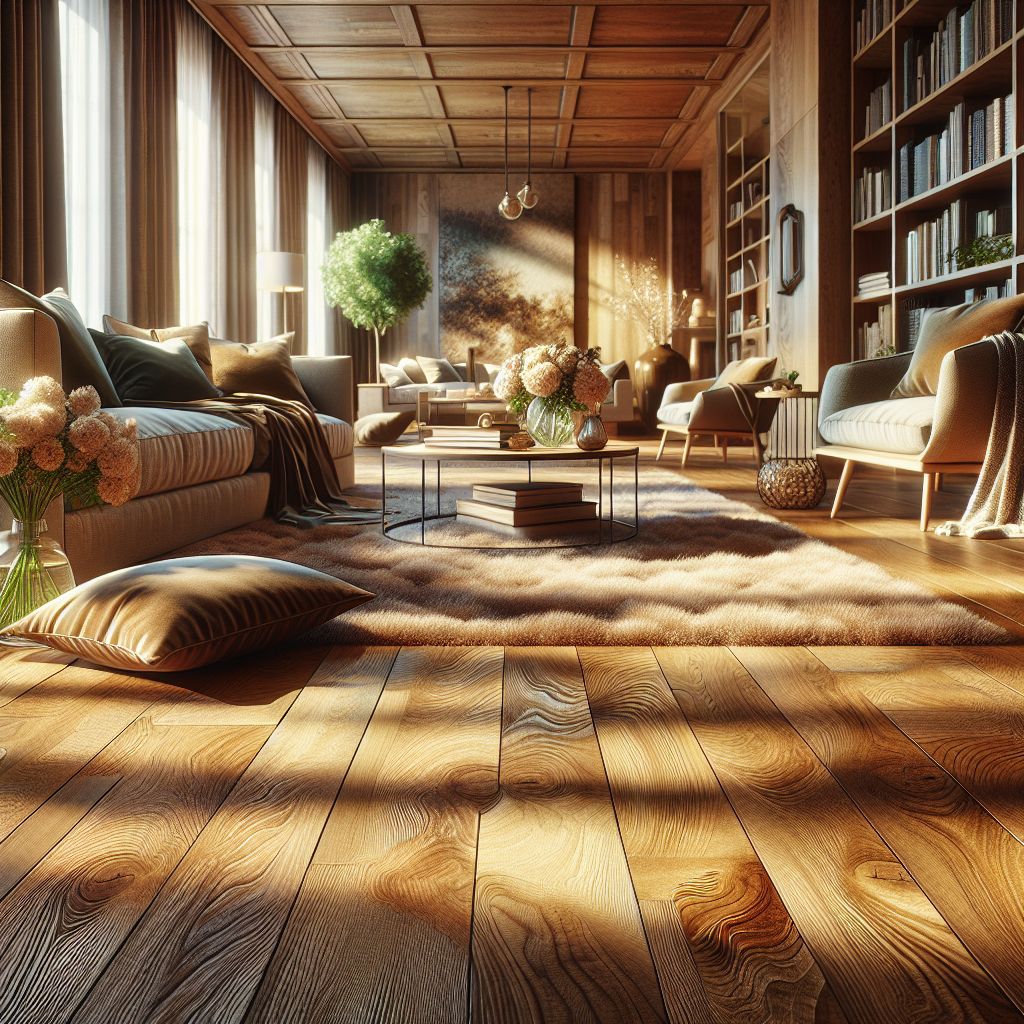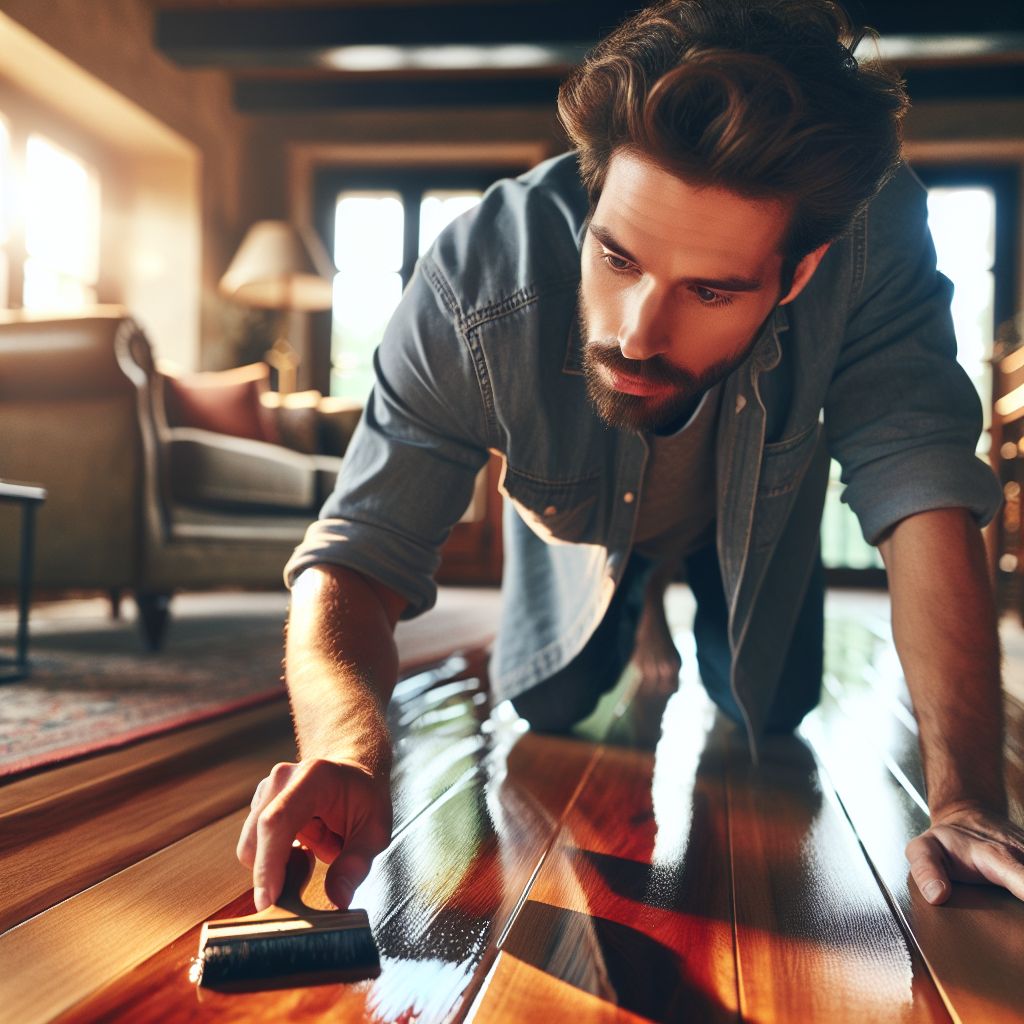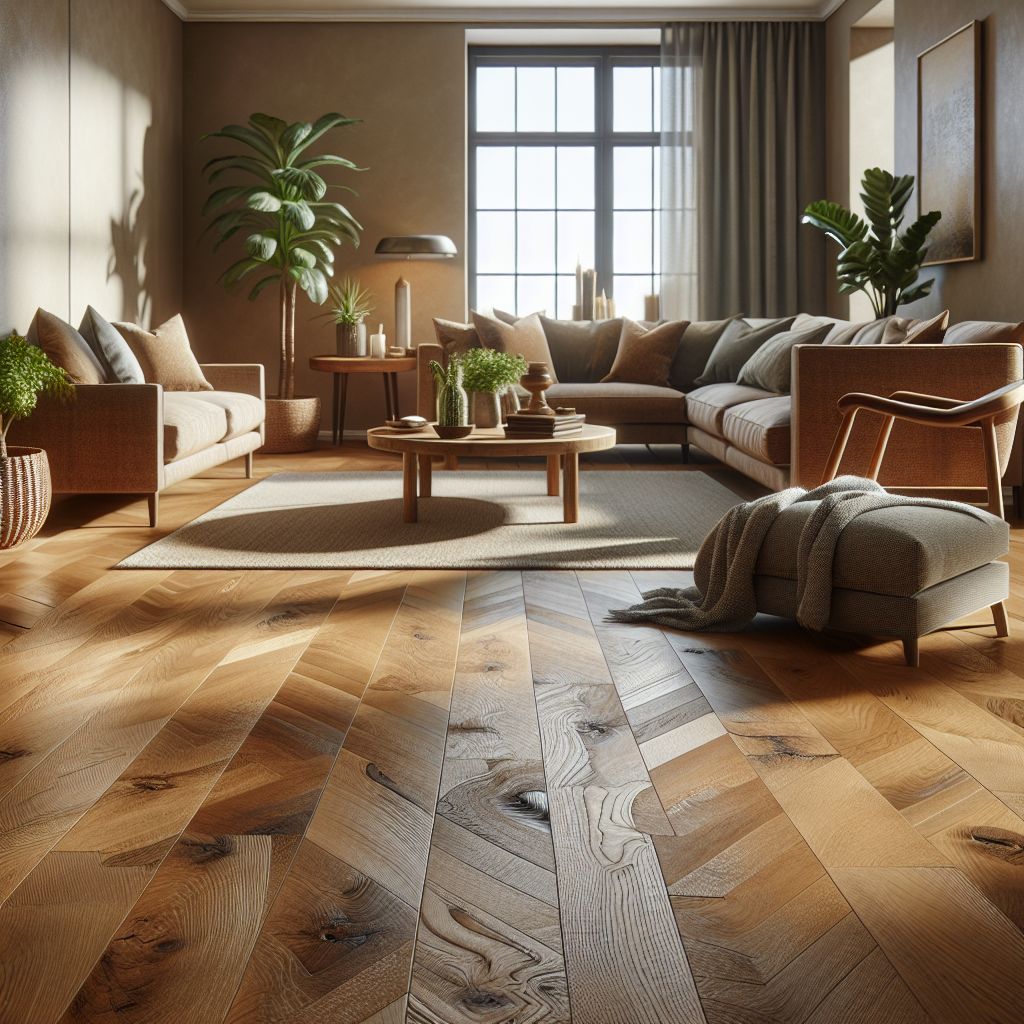
Key Takeaways
- Refinishing oak floors can enhance your home’s value and aesthetic appeal.
- You’ll need specific tools and materials, such as a sander, stain, and protective gear.
- Preparation is essential—clear the room and inspect the floors for damage before starting.
- Sanding is the most labor-intensive step, but it’s essential for a smooth finish.
- With patience and attention to detail, you can achieve professional-quality results.
The Impact of Refinished Floors on Your Home
Refinished floors can breathe new life into your space. Not only do they look beautiful, but they also increase the value of your home. It’s a cost-effective way to make a significant impact with costs averaging $2 to $7 per square foot. So, whether you’re sprucing up to sell or just want to enjoy your home’s renewed beauty, refinishing your floors is a smart move.
Roll Up Your Sleeves: It’s Time to Refinish Those Oak Floors!
Imagine walking into a room with gleaming oak floors that reflect the light and add a warm, inviting glow to your home. It’s not just a dream. With a little effort and the right guidance, you can make it a reality. Refinishing your oak wood floors can be a gratifying project, so let’s get started on this transformative journey.
What You’ll Need to Get Started
First things first, let’s talk about what you’ll need. You don’t want to be halfway through the job and realize you’re missing an essential tool. Here’s a quick rundown:
- A drum or orbital sander (rentable from most hardware stores)
- Sanding paper of various grits (start with 40-grit and go up to 120-grit or higher)
- A vacuum and tack cloth for dust removal
- Wood filler for patching up any imperfections
- Stains and finishes of your choice
- Protective gear such as goggles, a dust mask, and ear protection

Step-by-Step Guide to Refinishing Oak Wood Floors
Embarking on the journey of refinishing oak wood floors is not merely a restoration project, but a transformative endeavor that breathes new life into spaces and revives the character of a home. Whether you’re a seasoned DIY enthusiast or a beginner ready to take on your first home improvement adventure, here’s what you need to do:
Step 1: Clearing the Space
Before you can begin the transformation, you need a blank canvas. Move all furniture, rugs, and personal items out of the room. You want to have unobstructed access to the entire floor. Think of it as a great opportunity to declutter!
Step 2: Inspecting for Repairs
With everything out of the way, inspect the floor for any damage. Look for deep scratches, loose boards, or areas that might need wood filler. Addressing these issues now will ensure a smoother refinishing process.
Step 3: Prepping the Stage
Having the right tools at hand is essential. Make sure your sander is in good working order and you have plenty of sandpaper. Remember, it’s better to have too much than to run out mid-project.
Seal off the room with plastic sheeting to keep dust contained. Also, don’t forget to protect yourself. Wear long sleeves, pants, and closed-toe shoes. Safety should always come first.
Step 4: Sanding
Start with a coarse 40-grit sandpaper to remove the old finish and any major imperfections. As the floor smoothens, switch to finer grits, such as 80-grit and then 120-grit, to refine the surface.
Step 5: Staining
Remember, the longer you leave the stain on, the darker it will be. So, if you’re going for a lighter look, be ready to wipe it off quickly.
- Apply the stain with a lint-free cloth or a brush, working in manageable sections.
- Start at one end of the room and work your way to the other, blending the edges as you go to avoid lines.
- Wipe off excess stain with another clean cloth to avoid a mottled look.
- Allow the stain to dry completely according to the manufacturer’s instructions before applying the finish.
Step 6: Sealing the Deal
Once the stain has dried, it’s time to protect your floors with a finish. This will seal in the color and protect the wood from everyday wear and tear. Here’s how to properly do it:
- Choose a suitable high-quality sealant for oak flooring, such as polyurethane, varnish, or oil-based options, taking into account factors like durability, sheen level, and application ease.
- Ensure good ventilation throughout the process. Use painter’s tape to protect baseboards, walls, and any adjacent surfaces from accidental drips or spills.
- Apply thin even coats of sealant evenly using a brush, roller, or lambswool applicator, following the wood grain. Start from the far corner of the room, working your way toward the exit to avoid stepping on the freshly sealed areas.
- For optimal smoothness and adhesion between coats, lightly sand the surface with fine-grit sandpaper (e.g., 220-grit) after each coat has dried. Remove sanding dust with a vacuum or tack cloth before applying the next coat.
- Apply multiple coats of sealant as recommended by the manufacturer, typically two to three coats for adequate protection. Ensure each coat is fully dry before applying the next.

Pro Tips: Oak Floor Refinishing Done Right
Refinishing oak floors is not just about following steps; it’s about understanding the wood and how it reacts to different treatments. Oak is a hardy wood, but it still requires a gentle touch and a bit of know-how. When refinishing oak floors, it’s important to take into account the age and wear of the wood, as well as any existing finishes that may need to be removed. The same principles apply when undertaking oak dining table refinishing, as both surfaces require careful consideration and skill to bring out their natural beauty. With the right knowledge and techniques, oak can be transformed into a stunning and durable feature in any home.
Sanding Technique
Sanding requires a steady hand and patience. Move the sander in smooth, even strokes, going with the grain of the wood. It’s essential not to linger in one spot to avoid uneven surfaces.
If you encounter stubborn old finish that won’t sand off, try using a chemical stripper first, then sanding. This can save you time and sandpaper. For those pesky corners and edges that a drum sander can’t reach, use an edge sander or a hand scraper. Just be careful not to gouge the wood.
And if you’re dealing with deep scratches or dents, wood filler is your friend. Choose a filler that’s stainable and matches the color of your oak floors.
Dealing with Dust
As you sand, dust will become your new best friend, but it’s a friendship you’ll want to manage. A combination of vacuuming and wiping down with a tack cloth between grit changes is your best bet. It’s important to remove all dust before moving on to staining; otherwise, you’ll end up with a rough finish.
Selecting the Perfect Finish
When selecting a finish, consider the level of gloss you want long-term. High gloss finishes are more durable but will show scratches more easily, while matte finishes can hide imperfections better. It’s all about what works for your home and lifestyle.
Also, think about the maintenance each type of finish requires. Some finishes may need more frequent touch-ups or specific cleaning methods.
Applying Stain Like a Pro
Staining your floors is where the magic happens. It’s the step where your hard work starts to show, and your floors begin to take on a new life.
When applying stain, work with the grain, not against it. Always test your stain on an inconspicuous area or on a spare piece of wood. This will give you an idea of the final color and allow you to make adjustments before committing to the entire floor. Be aware that oak’s open grain can absorb stain unevenly, so consider using a pre-stain conditioner to achieve a more uniform color.
Application Tips for a Smooth Finish
Applying finish requires a similar approach to staining: smooth, even strokes with the grain. Use a high-quality brush or a lambswool applicator for the best results. And remember, thin coats are better than thick ones. They dry faster and reduce the risk of bubbles.
Between coats, you’ll need to sand lightly with a fine-grit sandpaper or a sanding screen. This ensures the next coat adheres properly. Just don’t forget to clean up the dust afterward!
Drying and Curing Time
Understanding the drying and curing time is essential when applying sealant to oak flooring. Drying time refers to the period required for the sealant to become touch dry, allowing for the application of subsequent coats or for light foot traffic. On the other hand, curing time refers to the duration needed for the sealant to fully harden and provide maximum protection. Adhering to these timelines ensures optimal results, longevity, and durability of the sealant on the oak floor, preserving its finish and preventing premature wear.
- Drying Time: Allow the final coat of sealant to dry completely according to the manufacturer’s instructions before allowing foot traffic on the floor. This may take anywhere from 24 to 72 hours, depending on the type of sealant and environmental conditions.
- Curing: It’s essential to allow the sealant to cure fully before placing heavy furniture or rugs on the floor. This curing process typically takes a few days to a couple of weeks, depending on the type of sealant used.

Maintaining Your Masterpiece
Once your floors are beautifully refinished, you’ll want to keep them that way. Here’s what you need to know.
Regular Cleaning Guide
Keeping your refinished oak floors looking new is all about regular, gentle cleaning. Use a soft-bristled broom or a microfiber mop to sweep away any dirt or debris. This should be done daily, or at least every other day, to prevent any buildup that can scratch the surface.
For a deeper clean, use a pH-neutral cleaner designed for wood floors. Dampen your mop slightly with the solution and go over the floors, being careful not to let any water pool. Water is the enemy of wood floors, so less is definitely more here.
Pro Tip: Make your own wood floor cleaner by mixing 1/4 cup of mild dish soap into a bucket of water. Wring out your mop thoroughly to avoid leaving excess water on the floors.
Once a month, you can go for a more thorough cleaning with a wood floor cleaner. Spray it on and wipe it off with a dry mop or cloth. This will remove any grime that’s built up and keep your floors looking their best.
Preventing Damage and Scratches
Protecting your floors from scratches and damage is easier than you might think. Place mats at all entrances to catch dirt and grit from shoes. Encourage family and guests to remove their shoes upon entering your home to further reduce the risk of scratching.
Prevent scratches by using felt pads under furniture and keeping pet nails trimmed. And remember, the sun can fade your floors over time, so consider using curtains or UV-protective window film in sunny areas.
When to Call in the Professionals
Sometimes, despite our best efforts, a professional touch is needed. If you encounter issues like deep stains that won’t come out, warping from water damage, or you’re just not comfortable using the heavy equipment required for sanding, it’s time to call in the pros.
They have the expertise and equipment to tackle any job, big or small. And sometimes, they can spot potential problems that you might miss, saving you time and money in the long run.
Don’t hesitate to get quotes from several contractors and check their references. After all, your floors are an investment, and you want them in the best hands possible.

Frequently Asked Questions (FAQ)
How Long Does the Refinishing Process Take?
The refinishing process can take anywhere from a few days to a week, depending on the size of the area and the extent of the work needed. It includes prep time, sanding, staining, and applying multiple coats of finish, with adequate drying time in between.
Can I Refinish Floors Without Sanding?
Maybe – it depends on the condition of your floors. If your floors are only lightly scratched and the finish isn’t worn through, a process called ‘screening’ can be used. This involves lightly abrading the top layer of finish and then applying a new topcoat.
However, for deep scratches, dents, or if the finish has worn down to the wood, sanding is necessary to get down to a fresh layer of wood before refinishing.
What Are the Eco-Friendly Options for Floor Refinishing?
For an eco-friendly approach, look for water-based polyurethane finishes, which have lower volatile organic compound (VOC) levels. You can also use natural oils and waxes, which are biodegradable and less harmful to indoor air quality.
How Long Before You Can Walk on the Floors After Refinishing?
You can usually walk on the floors with socks after about 24 hours, but you should wait at least 48 hours before moving furniture back in. Rugs and heavy foot traffic should be avoided for at least a week to allow the finish to fully cure.
Does Refinishing Oak Floors Increase Home Value?
Yes, refinished hardwood floors are not only a visually appealing aspect of home decor, but they can also significantly increase your home’s value by 3-5%. They are highly sought after by homebuyers, which makes homes with well-maintained hardwood floors more attractive on the market. When taken care of, hardwood floors can last for decades, proving to be a wise long-term investment.
Refinishing your oak floors is not just about aesthetics; it’s a sound financial decision. Beautifully refinished floors can make your home stand out in a crowded market and attract buyers who are willing to pay a premium for move-in ready homes.





Leave a Reply